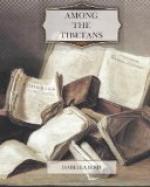After leaving Shergol the signs of Buddhism were universal and imposing, and the same may be said of the whole of the inhabited part of Lesser Tibet. Colossal figures of Shakya Thubba (Buddha) are carved on faces of rock, or in wood, stone, or gilded copper sit on lotus thrones in endless calm near villages of votaries. Chod-tens from twenty to a hundred feet in height, dedicated to ‘holy’ men, are scattered over elevated ground, or in imposing avenues line the approaches to hamlets and gonpos. There are also countless manis, dykes of stone from six to sixteen feet in width and from twenty feet to a fourth of a mile in length, roofed with flattish stones, inscribed by the lamas (monks) with the phrase Aum, &c., and purchased and deposited by those who wish to obtain any special benefit from the gods, such as a safe journey. Then there are prayer-mills, sometimes 150 in a row, which revolve easily by being brushed by the hand of the passer-by, larger prayer-cylinders which are turned by pulling ropes, and others larger still by water-power. The finest of the latter was in a temple overarching a perennial torrent, and was said to contain 20,000 repetitions of the mystic phrase, the fee to the worshipper for each revolution of the cylinder being from 1d. to 1s. 4d., according to his means or urgency.
The glory and pride of Ladak and Nubra are the gonpos, of which the illustrations give a slight idea. Their picturesqueness is absolutely enchanting. They are vast irregular piles of fantastic buildings, almost invariably crowning lofty isolated rocks or mountain spurs, reached by steep, rude rock staircases, chod-tens below and battlemented towers above, with temples, domes, bridges over chasms, spires, and scaffolded




